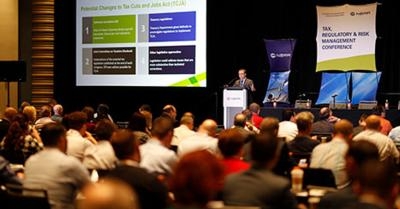Holds 2018 Tax, Regulatory And Risk Management Conference Just Ahead Of NBAA-BACE
Recent tax changes brought on by the Tax Cuts and Jobs Act (TCJA), permissible operating models, new transportation models and recent trends in business aircraft transitions and risk management were in focus of NBAA’s 2018 Tax, Regulatory & Risk Management Conference, preceding the NBAA Business Aviation Convention & Exhibition (NBAA-BACE) in Orlando, FL.

Keith Swirsky, president of GKG Law, P.C., presented on one significant impact of the TCJA specifically applicable to business aviation involving bonus depreciation of certain aircraft. Beginning September 2017 through Dec. 31, 2022, certain business assets acquired by the taxpayer or acquired pursuant to a written binding contract are eligible for bonus depreciation, with phase-downs available through Dec. 31, 2026.
A crucial change brought about by TCJA is the inclusion of used equipment as eligible property for bonus depreciation. Prior to the TCJA, bonus depreciation only applied to new equipment, he said.
Jed Wolcott, president of Wolcott & Associates, P.A., discussed IRS Notice 2018-76, published earlier this month, which provided interim guidance on the deductibility of expenses for business meals under the TCJA.
“The notice clarified the taxpayer may generally continue to deduct 50 percent of the food and beverage expenses associated with operating their trade or business, assuming the expenses fall under ordinary and necessary expenses related to that taxpayer’s trade or business,” said Wolcott.
Wolcott explained this notice may have implications for business aircraft use. For example, if a meal is not considered entertainment, and is therefore deductible, is the transportation to and from that meal also deductible? Wolcott warned the notice isn’t entirely clear on whether transportation to and from the meal would be deductible.
New transportation models also were in focus at the conference, when John Copley, partner of Garofalo Goerlich Hainbach PC, and Eileen Gleimer, partner and chair of the aviation group at Crowell & Moring LLP, discussed per-seat sales, self-aggregation, ridesharing and other models coming on the market.
“These new models are just variations on a theme, based on the traditional whole aircraft charter model,” said Gleimer. Copley and Gleimer explained that what began as whole aircraft charter evolved to include fractional ownership programs, charter card programs, charter broker arrangements, membership programs and other models.
One model discussed was the use of self-aggregation for purposes of selling charter flights per-seat. In self-aggregation, passengers form their own group and then contract with an air carrier to conduct the flight. Recently published Department of Transportation (DOT) regulations mentions self-aggregation when seeking to regulate single entity, whole-aircraft charter – that is, a charter not directly or indirectly paid by individual passengers, except when individual passengers self-aggregate to form a single entity for flights.
“The real question DOT did not answer is how involved can a broker be in putting together groups of passengers and still have it qualify as self-aggregation,” said Copley, adding the DOT proposed rules do not clearly define self-aggregation or the qualities that make up self-aggregation.
(Image provided with NBAA news release)
 ANN's Daily Aero-Term (04.30.24): Runway Centerline Lighting
ANN's Daily Aero-Term (04.30.24): Runway Centerline Lighting ANN's Daily Aero-Linx (04.30.24)
ANN's Daily Aero-Linx (04.30.24) Airborne 04.24.24: INTEGRAL E, Elixir USA, M700 RVSM
Airborne 04.24.24: INTEGRAL E, Elixir USA, M700 RVSM Airborne 04.29.24: EAA B-25 Rides, Textron 2024, G700 Deliveries
Airborne 04.29.24: EAA B-25 Rides, Textron 2024, G700 Deliveries Airborne-NextGen 04.23.24: UAVOS UVH 170, magni650 Engine, World eVTOL Directory
Airborne-NextGen 04.23.24: UAVOS UVH 170, magni650 Engine, World eVTOL Directory



